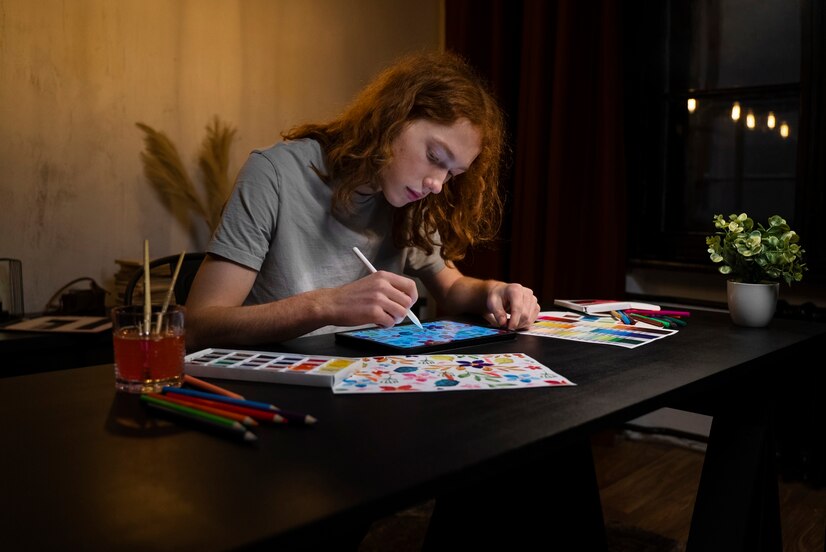Table of Contents
ToggleGetting into the University For The Creative Arts is not difficult. Competition varies across UCA’s diverse programmes. Popular fields like animation or fashion design might attract more applicants, potentially lower University of Creative Arts postgraduate acceptance rate compared to niche programmes. Additionally, each of the four UCA campuses caters to slightly different specialisations, so research your preferred location and programme thoroughly.
University For The Creative Arts Acceptance Rate Highlights
| Key Information | Details |
| University Name | University for the Creative Arts (UCA) |
| Acceptance Rate | 40% (Overall acceptance rate; specific rates may vary by programme) |
| Competition and Considerations | Varies across diverse programmes; popular fields may have higher competition; consider location and programme specialisation. |
| Admission Deadline | Varies by intake (September and January); earlier deadlines for international students; check specific programme pages for exact deadlines based on nationality. |
| Tuition Fees (Per Year) | Undergraduate (UK/EU): £9,250 – £12,750; Undergraduate (International): £13,500 – £25,250; Postgraduate (UK/EU): £11,250 – £18,500; Postgraduate (International): £16,500 – £33,750. Specific costs depend on programme and nationality. |
University For The Creative Arts Acceptance Rate
The University of Creative Arts masters acceptance rate is 40%, suggesting a welcoming environment for aspiring artists, designers, and performers. However, don’t underestimate the selection process. This number doesn’t guarantee admission, as your talent, academic record, and application strength ultimately determine your fate.
- Think of it this way –the 40% signifies an open door, but to walk through it, you need to showcase your potential. A stellar portfolio brimming with creativity and technical skills is your golden ticket. Strong academic results demonstrate your diligence and ability to handle the rigours of university life. Your statement, meanwhile, becomes your chance to tell your unique story, highlighting your passion, perseverance, and goals.
- Remember, competition varies across UCA’s diverse programmes. Popular fields like animation or fashion design might attract more applicants, potentially lowering your acceptance rate University of Creative Arts compared to niche programmes. Additionally, each of the four UCA campuses caters to slightly different specialisations, so research your preferred location and programme thoroughly.
Comparison With Other Universities
Selecting the right university is a must along with understanding the University for the Creative Arts admission process. Understanding how different institutions compare can be incredibly helpful. While the University for the Creative Arts (UCA) offers a renowned experience, exploring alternatives can broaden your horizon and help you find the perfect fit. Let’s delve into a comparison framework, considering various aspects:
Academic Focus And Programme Strength:
- Central Saint Martins: Boasts exceptional programmes in fashion, graphic design, and fine art, attracting a highly competitive applicant pool.
- Rhode Island School of Design: Offers a diverse range of art and design programmes with a strong emphasis on practical application and innovation.
- Falmouth University: Provides a wider range of programmes beyond traditional art and design, including animation, games, and maritime studies.
Location And Campus:
- UCA: Offers multiple campuses across England, each with its own character and strengths. Consider the urban energy of Farnham or the historical charm of Canterbury.
- University of Brighton: Enjoys a vibrant coastal location, attracting students drawn to its artistic and creative atmosphere.
- Emily Carr University of Art + Design: Located in Vancouver, Canada, this university provides a unique blend of urban energy and stunning natural surroundings.
Acceptance Rates And Admissions Criteria:
- Royal College of Art: Highly selective in seeking exceptional talent and a strong portfolio.
- National Film and Television School: Intensely competitive, requiring demonstrably high levels of creative potential and technical skills.
- University of the Arts Bournemouth: Slightly less competitive than UCA, with a focus on individual portfolios and creative potential.
Cost And Financial Aid:
- Parsons School of Design: The cost to study in the UK for Indian students is generally considered more expensive than UCA, although generous financial aid packages are available.
- Bauhaus-Universität Weimar: Relatively affordable for European students, but international fees can be higher. However, students must consider that the cost of living in the UK is considered higher!
- University of Westminster: Offers competitive tuition fees within the UK context, alongside scholarship opportunities.
Industry Connections And Career Support:
- Rhode Island School of Design: Boasts a strong alumni network and dedicated career services, facilitating connections with top creative industries.
- Central Saint Martins: Renowned for its industry partnerships and graduate success in leading fashion and design houses.
- Falmouth University: Provides industry placements and internships, fostering practical experience and professional connections.
Admissions Details For University For The Creative Arts
Admissions details for the University for the Creative Arts (UCA) vary between undergraduate and postgraduate programs, with specific eligibility criteria for Indian students. General requirements include academic qualifications, check them here:
Eligibility
The University of Creative Arts acceptance rate for Indian students has different eligibility requirements for undergraduate and postgraduate programmes. However, some general criteria apply to both:
- Academic qualifications: You’ll need to have completed relevant qualifications like A-levels, IB Diploma, or equivalent diplomas depending on your programme and region. Check the specific programme page for exact requirements.
- Portfolio: A strong portfolio showcasing your creative abilities is crucial for all applicants. Refer to programme-specific guidelines for format and content expectations.
- Personal statement: Demonstrate your passion for the chosen field, highlight relevant experiences, and explain why UCA is your ideal choice.
- Reference letters: Two academic references are typically required, providing insights into your academic performance and potential.
Additional Requirements For International Students:
- English language proficiency: You’ll need to meet UCA’s English language requirements through exams like IELTS or TOEFL. Specific score requirements vary by programme and level of study.
- Visa: For international students outside the UK/EU, obtaining a valid study visa is mandatory.
Admission Deadline
UCA operates two intakes: September and January. Application deadlines vary depending on your programme and nationality.
For UK/EU Students:
- September intake: The main deadline is usually in January, with late applications considered until June.
- January intake: Applications typically close in November, with some programmes accepting applications until December.
For International Students:
- Deadlines are generally earlier than for UK/EU students. Check the specific programme page for exact deadlines based on your nationality.
Fees At The University For The Creative Arts
Understanding tuition fees is crucial when planning your studies at UCA. Here’s a breakdown of both undergraduate and postgraduate programmes for several intakes in the UK.
| Undergraduate Fees | Postgraduate Fees | |
| UK/EU Students | Fees vary based on program and year, typically £9,250 to £12,750/year. | Vary by program and level (Master’s or PhD), usually £11,250 to £18,500/year. |
| International Students | Generally higher fees, ranging £13,500 to £25,250/year. | Higher than UK/EU fees, ranging £16,500 to £33,750/year. |
| Specific Costs | Dependent on programme and nationality. | The exact costs depend on programme and nationality. |
Admissions Chances
Students looking into getting into this university must understand that the admission chances are higher but the competition would also be directly proportional. Check some of the key occurrences here:
Academic Requirements:
- Check the specific programme page: Each programme at UCA has its entry requirements, including specific A-level subjects, grades, and portfolio expectations. Ensure you meet all the listed requirements thoroughly.
- Focus on quality, not just quantity: While good grades are important, a stellar portfolio showcasing your creative ability and potential is crucial. Invest time and effort into crafting a portfolio that reflects your unique artistic voice and technical skills.
Portfolio Strength:
- Go beyond basic skills: While demonstrating technical proficiency is essential, showcasing your creative vision, experimentation, and ability to tell a story through your work is equally important.
- Tailor your portfolio to the programme: Adapt your portfolio to showcase skills and styles relevant to the specific programme you’re applying to. Research the programme’s ethos and expectations to understand what they seek in applicants.
- Seek feedback: Get constructive feedback on your portfolio from experienced artists, teachers, or mentors. This can help you identify areas for improvement and present your work in the best possible light.
Personal Statement:
- Go beyond generic statements: Avoid generic statements about your love for art or design. Instead, demonstrate genuine passion and specific reasons for applying to UCA and the chosen programme. Highlight relevant experiences, personal growth, and how UCA aligns with your artistic goals.
- Showcasing your uniqueness: Let your personality shine through! Be genuine, and enthusiastic, and express what makes you a unique and valuable addition to the UCA community.
- Proofread carefully: Ensure your statement is free of grammatical errors and typos. First impressions matter, and a well-written statement showcases your attention to detail and communication skills.
Additional Factors:
- English language proficiency: If you’re an international student, ensure you meet the required English language test score, like IELTS or TOEFL. Demonstrating strong communication skills is essential for academic success.
- Extracurricular activities: Showcasing relevant extracurricular activities like participating in art competitions, volunteering in creative projects, or attending workshops can strengthen your application.
- Reference letters: Obtain strong reference letters from teachers, mentors, or professionals who can attest to your creativity, academic ability, and work ethic.
FAQs
1. What is the current University for the Creative Arts of London acceptance rate?
The reported acceptance rate varies significantly depending on the source, ranging from 40% to 77%. This discrepancy likely stems from differences in how acceptance rates are calculated and the specific programmes being considered. It’s best to use this information as a general guide rather than a precise measure of your chances.
2. Can you provide information on the University for the Creative Arts of London acceptance rate for international students?
Specific data on acceptance rates for international students isn’t readily available on the UCA website. However, some sources estimate it to be around 40%, but this information may not be entirely accurate and might vary depending on the programme and your origin country.
3. Are there specific programmes or majors with higher or lower acceptance rates at University for the Creative Arts of London?
Yes, programme popularity plays a significant role. Check the UCA website for individual programme pages, where you might find application statistics or mention their competitiveness.
4. How does the University for the Creative Arts of London’s acceptance rate compare to other universities in the region?
Direct comparisons are challenging due to varying methodologies in reporting acceptance rates. However, UCA’s rate generally falls within the range of other art and design universities in the UK.
5. Has the University for the Creative Arts of London acceptance rate changed in recent years, and if so, what are the trends?
The available data doesn’t provide a clear picture of historical trends. It’s best to rely on current information as factors constantly influence acceptance rates.

















1 thought on “Top PGDM Courses In Canada: Universities & Eligibility”
I have done Bachelor’s in Culinary Arts from India and completed my graduation in the year 2022 .I am 22 years old. After graduation, I have done 1 year paid internship from USA .Now, I would like to take occupational experience and learn culinary skills and also do masters in Culinary arts.How can I find the college n best course / country where I can persue studying further